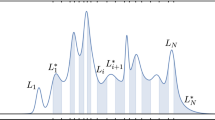Abstract
A lower bound on the grand partition function of a classical charge-symmetric system is adapted to the neutral grand canonical ensemble, in which the system is constrained to have zero total charge. This constraint permits us to consider two-body potentials that are only conditionally positive definite.
Similar content being viewed by others
Notes
A more general formula for \(\xi _0\) is given by (3.5).
See e.g. Ref. [2]. Note that in relativistic statistical thermodynamics, the term “canonical” is used to refer to the conservation of quantum numbers as opposed to particle numbers.
In (2.6) and below, \(\langle \phi , \varrho \rangle =\varrho (\phi )\).
Recall that \(\tilde{\lambda }_q = \exp (\tfrac{1}{2}\varepsilon ^2 q^2 u_0 ) \lambda _q.\)
References
Caillol, J.M., Levesque, D.: Numerical simulations of homogeneous and inhomogeneous ionic systems: an efficient alternative to the Ewald method. J. Chem. Phys. 94(1), 597–607 (1991). https://doi.org/10.1063/1.460326
Fochler, O., Vogel, S., Bleicher, M., Greiner, C., Koch-Steinheimer, P., Xu, Z.: Canonical strangeness suppression in microscopic transport models. Phys. Rev. C 74(3), 034902 (2006). https://doi.org/10.1103/PhysRevC.74.034902
Fontaine, J.R., Martin, P.A.: Equilibrium equations and symmetries of classical Coulomb systems. J. Stat. Phys. 36(1–2), 163–179 (1984). https://doi.org/10.1007/BF01015731
Fröhlich, J.: Some frontiers in constructive quantum field theory and equilibrium statistical mechanics. In: Dell’Antonio, G., Doplicher, S., Jona-Lasinio, G. (eds.) Mathematical Problems in Theoretical Physics. Lecture Notes in Physics, vol. 80, pp. 37–58. Springer, Berlin (1978). https://doi.org/10.1007/3-540-08853-9_4
Fröhlich, J., Spencer, T.: On the statistical mechanics of classical Coulomb and dipole gases. J. Stat. Phys. 24(4), 617–701 (1981). https://doi.org/10.1007/BF01011379
Kennedy, T.: A lower bound on the partition function for a classical charge symmetric system. J. Stat. Phys. 28(4), 633–638 (1982). https://doi.org/10.1007/BF01011872
Author information
Authors and Affiliations
Corresponding author
Additional information
Communicated by Eric A. Carlen.
Publisher's Note
Springer Nature remains neutral with regard to jurisdictional claims in published maps and institutional affiliations.
Appendix
Appendix
The Gaussian approximation \(\varXi _2\) can be computed explicitly. As an illustration, we give in this Appendix an explicit formula for the case of a Coulomb system in a torus
The interaction potential is assumed to be given by (1.2); that is,
where \(|\varLambda | = a^d\), \(\varLambda ^*=2 \pi a^{-1} {\mathbb {Z}}^d\), and
The parameter \(t > 0\) is an ultraviolet cutoff. (For \(d=1\) we may let \(t = 0\).) We assume the term \(u_0=u_0(t)\) introduced in (2.2) is chosen so that the energy
is finite.
For \(\phi \in \varPhi /\varTheta \) and \(p\in \varLambda ^*\setminus \{0\}\), let
(Recall that \(\pi ^*(\delta '_x) = \delta _x - \delta _{x_0}\), and note that \(\hat{\phi }_p\) is independent of the choice of basepoint \(x_0\).) The Fourier components \(\hat{\varrho }_p\) of a charge distribution \(\varrho \in (\varPhi /\varTheta )^*\) satisfy
for any \(\phi \in \varPhi /\varTheta \). Explicitly, if \(\varrho =\sum _{j=1}^n c_j \delta '_{x_j}\) with \(\sum _{j=1}^n c_j = 0\), then
We have
and
A standard calculation gives
In dimensions \(d < 4\), we can remove the ultraviolet cutoff in \(\varXi _2\) by letting t go to zero. The result is the Debye–Hückel approximation
Rights and permissions
About this article
Cite this article
Thompson, J.P., Sanchez, I.C. A Lower Bound on the Partition Function for a Strictly Neutral Charge-Symmetric System. J Stat Phys 177, 1207–1215 (2019). https://doi.org/10.1007/s10955-019-02416-y
Received:
Accepted:
Published:
Issue Date:
DOI: https://doi.org/10.1007/s10955-019-02416-y



